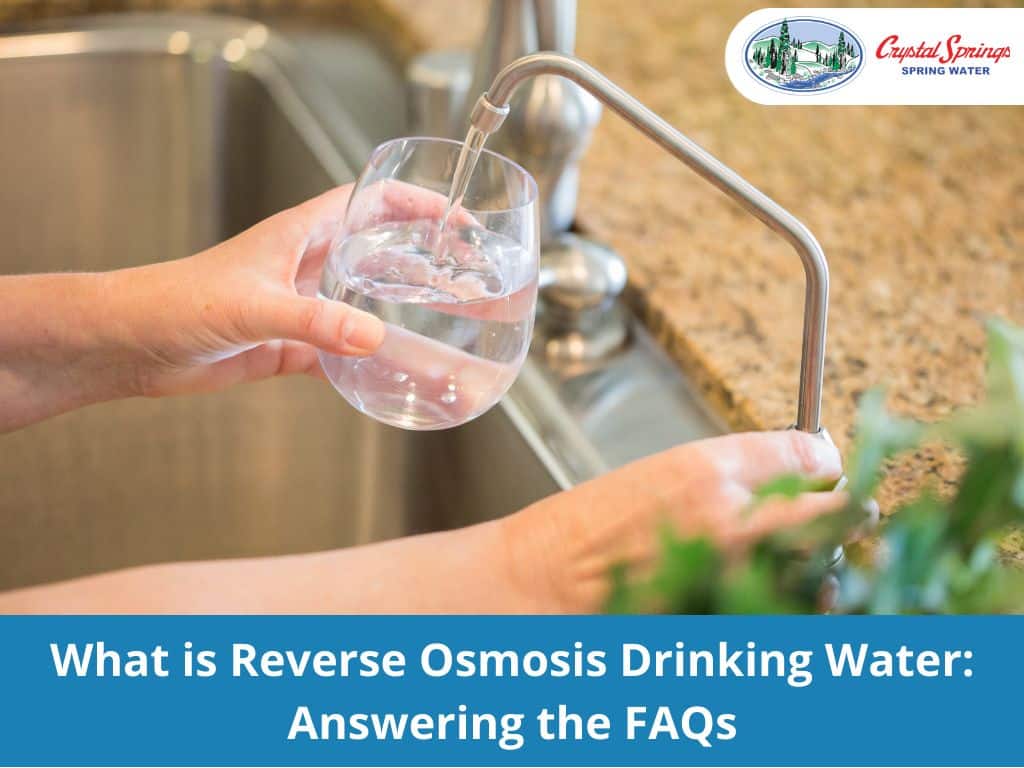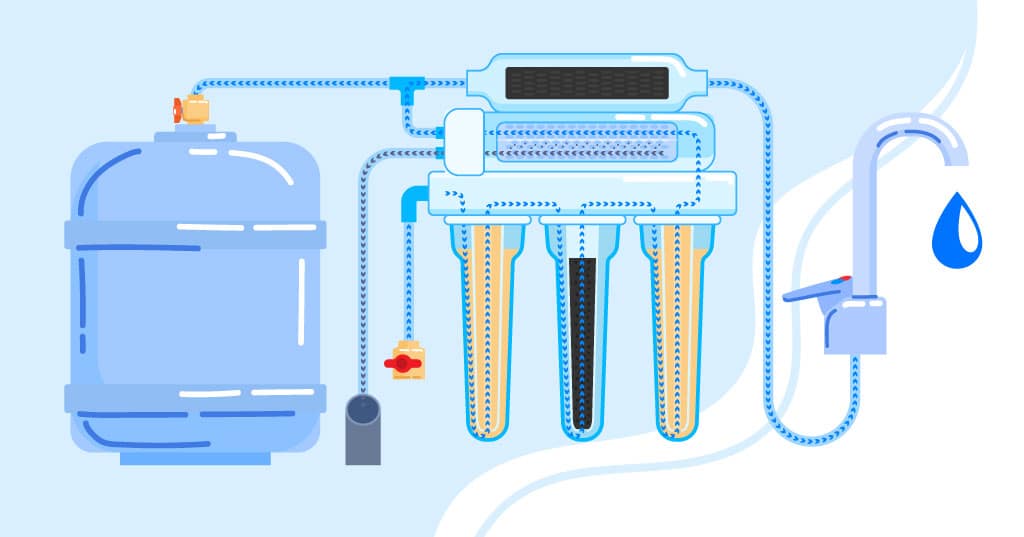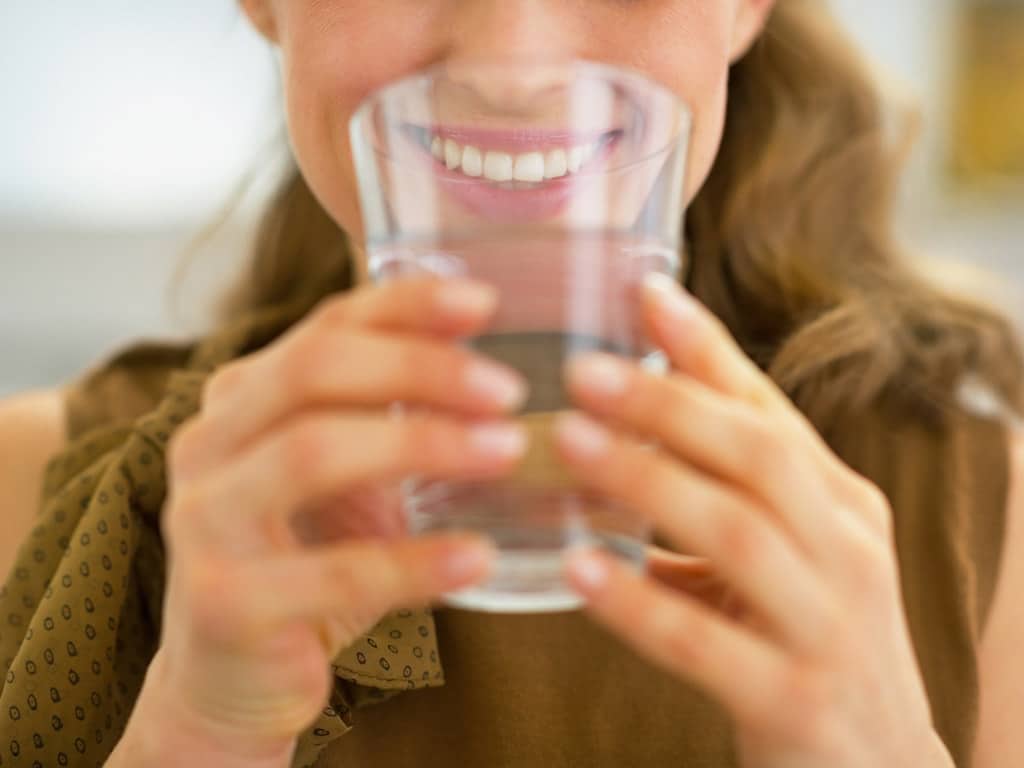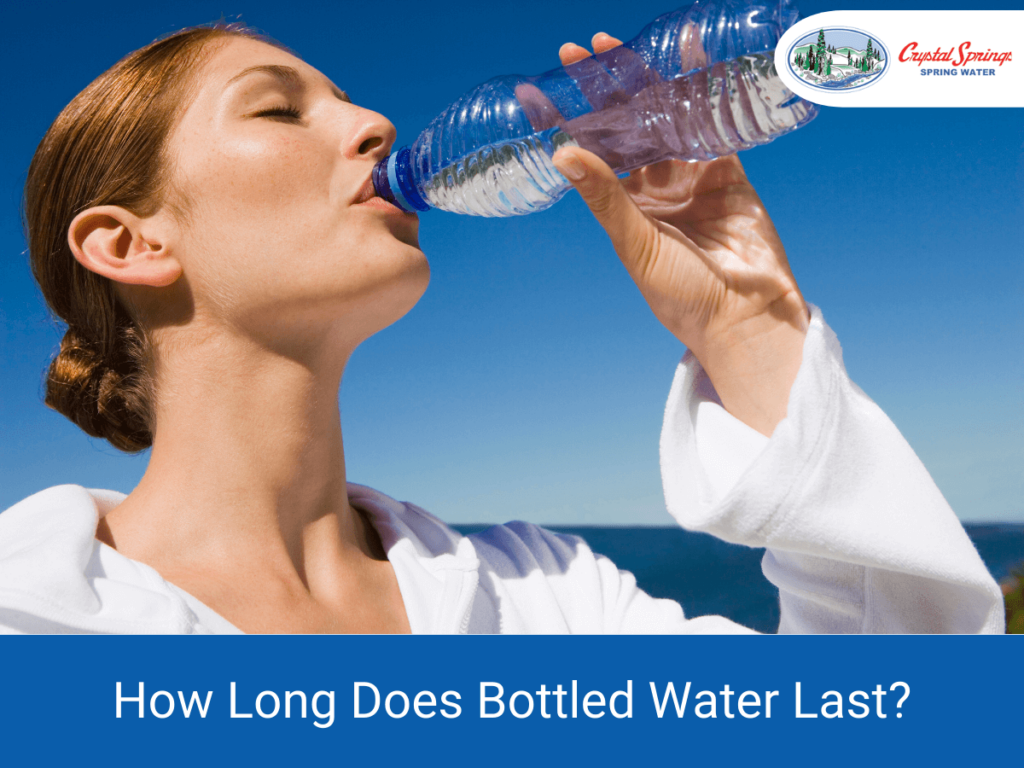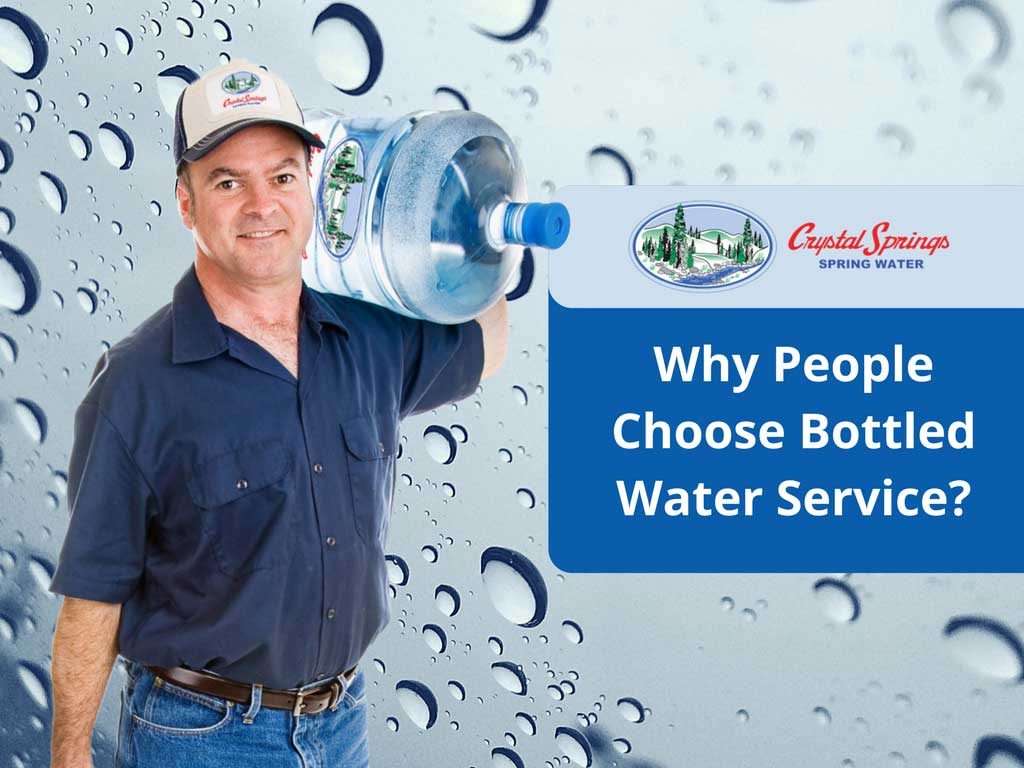What is Reverse Osmosis Drinking Water: Answering the FAQs
If you’ve browsed the isle of bottled water at your grocery store or researched H2O filters, you know that there are plenty of filtration options for drinking water. One option you may be familiar with is reverse osmosis (RO).
But unless you are an expert in water filtration, you may be wondering: what is reverse osmosis drinking water exactly?
Water is one of our most basic needs – but we often take its cleanliness for granted. Many of us assume that the water that flows from our kitchen sink tap is free from dangerous contaminants, such as bacteria, metals, or chemicals.
The water that comes out of our kitchen faucet is unfortunately not as clean as you may think. According to a report from the Natural Resources Defense Council, the water that supplies the homes of 77 million Americans actually violates multiple federal health regulations. Water from these sources contained dangerous contaminants including (but not limited to):
- Arsenic
- Copper
- Lead
- Pesticides
- Herbicides
- Aluminum
- Uranium
Filtration is designed to remove impurities and contaminants which can be harmful or distasteful. In some areas around the country, water filtration is necessary to create drinking water that is safe for consumption. But is RO the best option? What does it mean, how does it work, and is it safe?
At Crystal Springs Water, we like to consider ourselves the H2O experts.
So, we are going to answer some of the most common (and important) questions about RO filtration.
1. How Does a Reverse Osmosis System Work?
First and foremost, what is reverse osmosis drinking water filtration and how does it work?
Reverse osmosis (RO) systems use high pressure to force water through a semipermeable membrane filter. Only H2O molecules can fit through this membrane, but larger contaminant particles are caught in the filter. This results in truly purified water that does not contain any unnecessary or unwanted pollutants.
It is important to understand the process of osmosis compared to reverse osmosis.
In biology, osmosis is the process that occurs when a liquid passes through a semipermeable membrane. The molecules will move from the more concentrated side to the less concentrated to create equilibrium.
You can see osmosis occur by dropping a raisin into a glass of water. Water can pass through the semi-permeable membrane of the raisin, where its water concentration level is low. Eventually, the raisin will fill up with water until it cannot hold anymore – creating an equilibrium of water content.
In reverse osmosis, water moves from levels of higher concentration to lower, since the particles creating the more highly concentrated water are unable to pass through the membrane. This concentrated solution containing the filtered-out contaminants is called the waste or brine.
A RO filtering system contains three key elements:
- Sediment filter
- Carbon filter
- Semi-permeable membrane
The sediment filter removes suspended solids in H2O, such as dirt, dust, sand, or other pieces of debris. This is typically the first filter that the water runs through to get out any large pollutants.
Carbon filters use granular activated carbon (GAC) which absorbs organic chemicals. This can also help to remove unpleasant odors and flavors that may be in the water. It is commonly used to help with sulfur water, which can have a rotten egg odor.
The final filter is the semi-permeable membrane is commonly made from synthetic materials such as cellulose acetate, polysulfonate, or polyimide. These can filter out particles as small as .0001 microns – which is one-millionth of a meter.
Water flows from the storage tank through each of these filters until clean, pure H2O flows out on the other side. Generally, this process takes between 2 to 4 hours to filter around 3 gallons of water.
2. What Does a Reverse Osmosis System Remove?
RO filters remove nearly all contaminants that are commonly found in water supplies. This includes potentially dangerous contaminants, such as bacteria, pesticides, arsenic, and much more. RO filters remove far more contaminants than other types of filtration systems.
RO filtration systems also help to reduce hard water, which contains excessive amounts of calcium and magnesium. This type of H2O can result in a build-up within the pipes and be harsh when used for cleaning and bathing.
According to the Centers for Disease Control, these types of contaminants can cause severe health problems.
Chemicals such as arsenic, radon, and uranium can cause kidney damage and even increase a person’s risk of cancer. Contaminants from pesticides or fertilizers can harm the nervous system. There are often trace amounts of diseases or pharmaceutical waste found in the water. This could lead to reproductive issues and gastrointestinal diseases.
The H2O that feeds most homes and businesses from city water plants is regulated, meaning that it is allowed to contain specific levels of these contaminants. Occasionally, levels of bacteria or other impurities will rise, leading to outbreaks. The most common public water system outbreaks are:
- Legionella
- Norovirus
- Shigella
- Campylobacter
- Copper
- Salmonella
- Hepatitis A
- E. coli
- Excess fluoride
These outbreaks can cause a laundry list of health issues, but the most common effects are diarrhea, vomiting, fever, stomach pain, and headache. Long-term exposure to contaminated water can be fatal, especially for people with compromised immune systems such as children, the elderly, or people with cancer or autoimmune diseases.
RO water is also free from parasites like cryptosporidium or Giardia, which can be extremely harmful to the digestive tract. They are sometimes found in private wells as well as water from lakes or ponds. Ingesting these parasites can lead to numerous types of infections or giardiasis, a diarrheal disease.
According to the CDC, RO filtration is the most effective way to remove these dangerous parasites from drinking water.
RO filtration systems can remove up to 98% of these common contaminants, including fluoride, salt, chlorine, arsenic, herbicides, and pesticides. It is not able to remove all traces of bacteria – but water directed from a city treatment plant is treated already to remove any harmful bacteria.
3. Is Reverse Osmosis Drinking Water Better for You?
One of the greatest health benefits that RO filtered water offers is reduced exposure to potentially dangerous contaminants. This can reduce a person’s risk of developing health complications caused by exposure.
Additionally, RO drinking water does not contain fluoride or chlorine which is typically added to city water sources. There have been some scientific studies showing that excessive amounts of fluoride can be harmful to children’s developing bodies. Additionally, an excess amount of chlorine can be toxic as well.
For this reason, many people consider reverse osmosis drinking water to be the best and most healthy type to drink. However, it should be noted that the purification system removes natural minerals, which can provide numerous health benefits.
Natural water sources generally contain magnesium, calcium, sodium, and zinc. These minerals help the body in several ways, from brain development to bone density. However, these minerals can be supplemented in food sources and with supplements, rather than through just drinking water alone.
There is a common misconception that RO drinking water is more acidic than unfiltered water. The acidity of a solution ranges from 0 to 14, with 0 being highly acidic, 7 neutral, and 14 being alkaline. Normal water from the hap has a pH level of 7. But its acidity level increases to 5.5 once it is ingested and comes in contact with stomach acid.
The RO filtration process increases the Ph level of the water to 6.5, meaning that it is slightly more acidic than natural water. However, it is not more harmful to the body and it will not have any negative effects. And according to the US Environmental Protection Agency, it is perfectly safe to consume water with a pH range of 6.5 to 8.5.
RO water is also clearer rather than cloudy, like some tap waters. It is also said to have a better “taste” than other types of water. Minerals and additives like chlorine can have a strange and sometimes unpleasant aftertaste to them. RO drinking water does not have this. So, this may encourage you and your family to drink more water – which has incredible health benefits in and of itself.
4. Does Reverse Osmosis Waste Water?
Since the RO filtration system separates the waste (or bile) from the drinkable water, some people assume that the process is wasteful.
This waste is simply dumped down the drain along with the rest of the wastewater runoff to a treatment center. For every gallon of filtered RO water produced, about four gallons of water returns to the drain with the brine.
This may sound incredibly wasteful and harmful to the environment. However, this water that is returned to the drain is not necessarily wasted. It can be routed to a water recycling center, along with additional wastewater from the sink, dishwasher, shower, and washing machine. This water will be cleaned and can be used for agricultural and irrigation purposes.
Further, there are ways to make a RO filtration system more efficient and less wasteful.
First, a permeate pump can be installed, which can reduce the wastewater runoff significantly. Permeate pumps store the brine in a chamber and uses it to create pressure to continuously move new water through the filtration system. This helps to support a more efficient process and reuses the reject water before sending it back down the drain.
An automatic shut-off (ASO) valve can be installed into the system to prevent water from flowing once the storage tank is full. This will shut off the filtration system temporarily until the water level decreases once the drain is turned on.
It is also important to note that while the brine may not be drinkable water, it is still water that can be beneficial to the environment. RO water runoff has a higher concentration of dissolved organics – which can help waste treatment centers run more efficiently. This water ensures that no new chemicals are introduced into the water supply, speeding up the recycling process.
Another concern with RO filtration is that the filter may need to be replaced frequently, depending on the concentration level of contaminants in the water. This filter must be disposed of properly since it will be saturated with potentially harmful bacteria, parasites, or chemicals.
Thankfully, some types of RO filters can be recycled rather than just thrown away. Some states and cities offer special recycling programs or have drop-off centers specifically designed for filtration disposal.
It should also be stated that using a RO filtration system is far better for the environment than single-use plastic water bottles. While bottled water is certainly convenient and the bottles can be recycled, refilling reusable bottles on your own is better for the earth. Having an RO system in your home or office space allows you to access clean, safe drinking water at all times.
5. How Long Do Reverse Osmosis Systems Last?
If you decide to have a reverse osmosis filtration system installed in your home, you can use it consistently for about 10 to 15 years. You will need to keep up with scheduled filter changes and occasional maintenance, but the system itself can last for years with no issues.
There are several options for in-home RO filters. One of the most popular choices is an under-sink reverse osmosis drinking water system. You can hire a professional service to install the filter system, as it may require some plumbing and carpentry skills.
First, the RO unit needs to be connected to the home’s water source through the inlet valve. This must be attached to the “cold” water valve. There are several attachment types, depending on the size of the water valve and system. An EZ adapter may be used to fit the valves together snuggly so that no water leaks through.
Next, the filter assembly must be attached securely to the back or sidewall of the space below the sink. Some filtration systems have height requirements (i.e. must be six inches above the ground). These filters generally take up very little space – you will barely even notice they are there.
Some RO filtration systems will run directly through the kitchen sink faucet, but most will have a separate faucet altogether. In this case, a hole may need to be drilled in the sink or countertop to feed the hose through. It can be used in place of a spray hose on the side of the sink.
You may also want to consider installing a reverse osmosis tank so you can have several gallons of clean, filtered water available at all times. These tanks range in size from 2 to 10 gallons, depending on how much water you plan to use at a time. Smaller tanks may also fit under the sink, but larger tanks may need their own space. Some homeowners will install their tank in the crawlspace or basement beneath the kitchen and use a booster pump to send the water back up to the faucet.
Once all of the feed water lines are attached from the cold-water source through the filter to the faucet, the system is ready for use. It will take between 4 to 10 hours to fill up the initial storage tank and it is recommended to let the water run for a few minutes after it is installed before drinking the water.
If you do not want to permanently install an under-the-sink RO filter or you need reverse osmosis drinking water in an office space, you can also have it delivered. Crystal Springs Water conveniently offers drive-up, drop-off delivery services for residential and commercial buildings.
Crystal Springs Water also offers water filtration floor models for rent to make filtration and water access easy and convenient.
The PureFlo Bright Reverse Osmosis uses smart technology to monitor filtration efficiency and alert when it is time to replace the filter. This system will also send notifications to your smartphone if any leaks occur or maintenance is needed for any reason.
6. Is Reverse Osmosis Water Only for Drinking?
RO water is designed to be safe for ingestion. In fact, some would argue that it is the safest type of water since it contains just H2O and is free from any contaminants. Therefore, it is most commonly used for drinking and ingesting purposes.
It is quite uncommon for an entire home to use reverse osmosis filtration for all water sources, except for certain circumstances.
For instance, if you live in an area of the country with extremely hard water (high in minerals) or soft water (high in sodium), then you may want a RO system installed. Over time, hard or soft water can leave stains in the sinks and tub. They may also wear down your clothes faster in the washing cycle.
Additionally, RO systems remove all types of chemicals and pollutants which can be harmful, especially to children and the elderly. For this reason, some homeowners will opt to have a full RO system installed to filter all of their water.
Conclusion
Accessing clean, pure H2O shouldn’t be something we take for granted. However, much of the water that we assume is safe could be full of potentially dangerous contaminants. Reverse osmosis drinking water can provide you with the peace of mind that you are ingesting only the cleanest water on the market.
If you are interested in setting up a water delivery service or renting a reverse osmosis drinking water stand-up filter, please contact our team at Crystal Springs Water. We offer water and beverage delivery right to your home or office space. Our experts can also teach you more about RO drinking water and get you set up with a filtration system rental right away.
First Published on: Feb 25, 2021
Updated on: May 16, 2022


